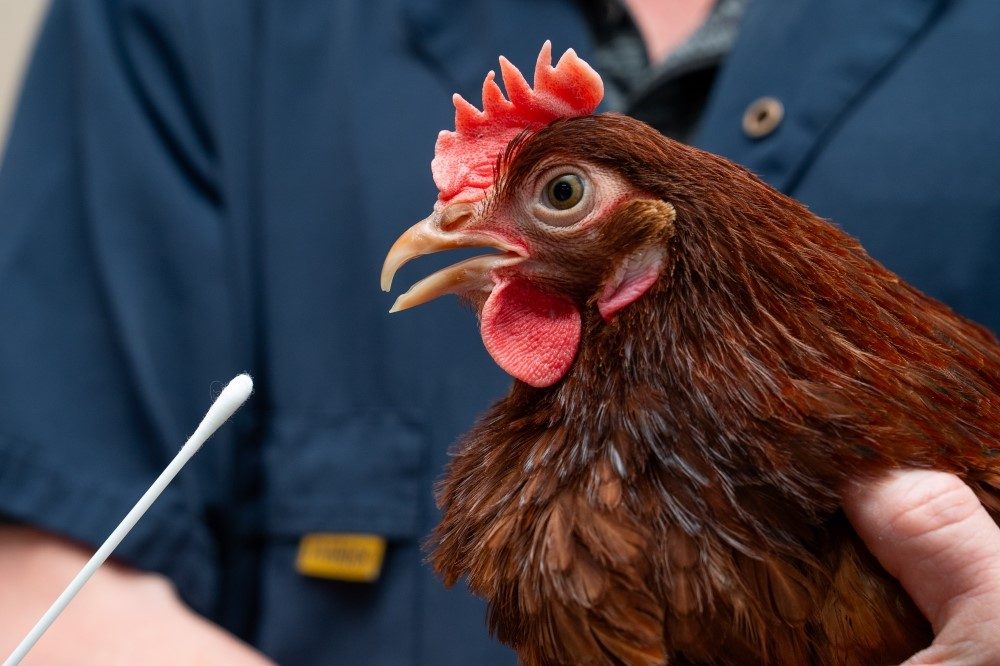
Highly pathogenic avian influenza reached Antarctica’s mainland in early 2024, leaving Australia, New Zealand and Pacific Island nations as the only regions on Earth that remain free from the H5N1 strain.
Purdue University researchers now have developed an innovative, paper-based diagnostic test for rapidly detecting avian influenza, the main cause of recent high egg prices. This novel test addresses the urgent need for an efficient and cost-effective surveillance tool to combat the global threat posed by avian influenza viruses, said Mohamed Kamel, a Purdue postdoctoral research associate.
This assay is suitable for use in field settings, including areas with limited access to advanced laboratory facilities. Kamel and four co-authors published the details of their new assay in the journal Scientific Reports.
A key advantage of the test is potential use across a variety of species, said lead author Mohit Verma, associate professor in the Department of Agricultural and Biological Engineering and the Weldon School of Biomedical Engineering.
“It works by using an oral or nasal swab from an animal or human and then transferring the sample to the paper-based devices,” Verma said. The test should work across different livestock (poultry, dairy) and wildlife (birds, rodents), as well as humans.
“The role of avian flu, particularly highly pathogenic avian influenza, in contributing to the high cost of eggs now and in the future, can be understood through its impact on the poultry industry,” Kamel said. In 2022, avian influenza outbreaks affected 67 countries and resulted in the loss of 131 million domestic poultry. U.S. losses totaled 40 million animals and $2.5 to $3 billion.
“Such large-scale losses in poultry directly reduce the supply of eggs, which can drive up prices due to decreased availability,” said Kamel, who is also a faculty member at Cairo University in Egypt.
Other factors add to the costs. Farmers must implement rigorous and expensive protective measures. These include enhanced sanitation, restricted farm access, and separation of wild and domestic birds, he noted. And the need for stringent biosecurity measures and trade restrictions following avian influenza outbreaks can further strain the market.
Key features of the paper-based assay, which uses loop-mediated isothermal amplification (LAMP), are its simplicity and accessibility, Kamel said. “Unlike conventional laboratory tests, it requires minimal training and only a water bath for incubation, enabling it to deliver results visible to the naked eye.”
The LAMP assay specifically targets the H5 hemagglutinin gene of the avian influenza virus. This assay offers important advantages over traditional diagnostic methods, Kamel noted. It detects the ribonucleic acid (RNA) from H5N1 strain of the avian influenza virus with 100% analytical sensitivity and specificity in test samples. The system is able to detect RNA down to 500 copies per reaction (25 copies/microliter). Highly specific to H5N1, the assay showed no evidence of cross-reactivity with 16 different bird and cattle pathogens during thorough validation experiments and comparative tests with standard quantitative polymerase chain reaction techniques.
Last year, Verma’s team announced a paper-based biosensor that offers fast, easy detection of fecal contamination on produce farms. His team had previously invented similar tests for bovine respiratory disease and COVID-19.
The potential applications of the new technology extend beyond its current capabilities, Kamel noted. Further enhancements could include multiplex testing to detect various influenza subtypes simultaneously as well as other pathogens.
Such enhancements could offer a practical solution to improve future global surveillance and control of avian influenza outbreaks. “The continuous threat of highly pathogenic avian influenza and its potential to infect other animals and humans underscores the importance of developing efficient diagnostic tools,” Kamel said.
The technology behind the assay is owned by the Purdue Research Foundation and is exclusively licensed to Krishi, a startup company where Verma serves as chief technology officer. The license was granted by the Purdue Innovates Office of Technology Commercialization. Krishi has just launched SherpaTM as a platform field-deployable technology, which could incorporate the H5N1 test if needed. Krishi is a Purdue Strategic Ventures portfolio company.
“This test is compatible with the technology that Krishi has recently launched for detecting antimicrobial resistance genes in cattle and so could be deployed quickly if we receive interest and support,” Verma said.
The U.S. Centers for Disease Control and Prevention currently assess the public health risk of H5 bird flu as low. The virus may require just one key mutation to improve its ability to infect human respiratory cells, Kamel noted.
“The H5N1 avian influenza virus presents a concerning but not yet imminent threat that warrants serious attention,” he said. The virus has shown an increasing ability to cross species barriers, spreading extensively among birds and into mammals including cattle, cats and dogs.
“As of March 2025, the United States reported 70 human cases of H5N1 infection, with at least one death,” he said. Most cases were associated with exposure to infected animals. No sustained human-to-human transmission has yet been identified.
“As the virus continues to impact both the poultry industry and public health worldwide, this diagnostic tool could play a crucial role in mitigating the spread of the disease and safeguarding both animal and human health,” Kamel said.
This work was funded in part by the Foundation for Food and Agriculture Research and one of the researchers was supported through the Clinical and Translational Sciences Award from the National Center for Advancing Translational Sciences.




